Working Group Neutron Scattering
Current research interests:
|
|
Nematicity and Electron-Phonon Coupling in Superconductors
Our group has a long experience in the research in both conventional, i.e. phonon mediated, and unconventional high-temperature superconductors. In particular, the lattice dynamical properties and the coupling between the lattice vibrations and the electronic subsystem are studied (s. Fig. 3). Phonon spectroscopy via inelastic neutron and x-ray scattering is a unique probe of conventional superconductors because electron-phonon coupling represents the coupling mechanism between two electrons forming the so-called Cooper pairs, which are the base of our understanding of superconductivity. Our studies reveal not only the relevance of particular phonon modes for the superconducting ground state [1][2] but reflect the opening of the superconducting energy gap [3][4][5]. Furthermore, we are able to investigate the competition between the superconducting and differently ordered ground state [6].
Phase competition directly relates to our studies in iron-based superconductors. Here, similar to cuprates and heavy-fermion compounds, superconductivity emerges in the direct neighborhood and in competition to magnetically ordered phases. Our group is investigating compounds of the so-called "122" and "11" families with the composition MFe2As2 (M: alkaline-earth-metal atom) and Fe1+yTe1-xSex, respectively, with the samples prepared and characterized in the New Quantum Materials department. Initially, studies of the undoped parent compounds (M = Ba, Sr, Ca) regarding the soft phonon modes of the simultaneous magnetic-nematic-structural phase transition were the focus [7] along with investigations of possible spin-phonon coupling [8]. More recently, we showed that phonon spectroscopy can be used to determine quantitatively the correlation length of the nematic fluctuations above a possible nematic-structural transition temperature (see Fig. 4)[9][10].
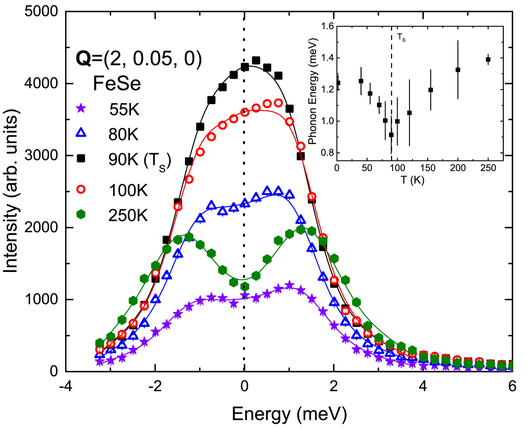
|
| Fig. 3: Inelastic x-ray scattering data for the soft phonon mode in FeSe across the structural phase transition temperature Ts = 90 K (1). The inset shows the temperature dependence of the phonon energy extracted from data in the main panel. |
|
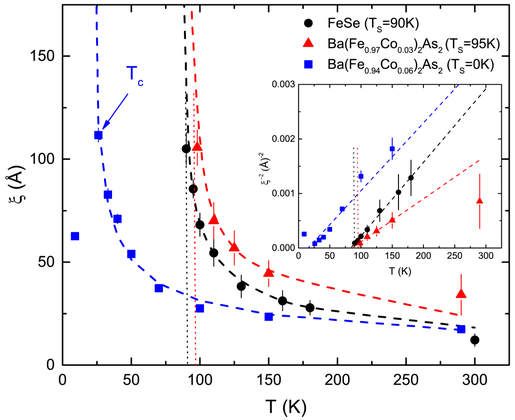
|
| Fig. 4: Correlation length ξ of nematic fluctuations in the three iron-based superconductors extracted from detailed dispersion measurements via inelastic x-ray scattering (1). The dashed lines are power-law fits of the form ξ = ξ0 × (T - T0)-1/2.The inset shows ξ-2 for the materials as in the main panel, with linear fits. |
|
Spin-phonon coupling in Mn1-xFex-yCoySi
The monosilicides MnSi, FeSi and CoSi have all the same cubic B-20 crystal structure, but the low temperature ground states range from weak itinerant ferromagnetism and strongly correlated insulating behaviour to a diamagnetic semimetal, respectively. The lack of inversion symmetry in the atomic structure induces a chiral Dzyaloshinsky-Moriya interaction between magnetic moments. As a result, MnSi and doped Fe1-yCoySi develop helical magnetic ordering at low temperatures. Interestingly, FeSi features a non-magnetic and insulating ground state. We could show that the linewidths, i.e. the damping, of some phonon modes scale with the well-known temperature-activated paramagnetism (see Fig. 5) highlighting FeSi as a material with direct spin-phonon coupling in these materials.
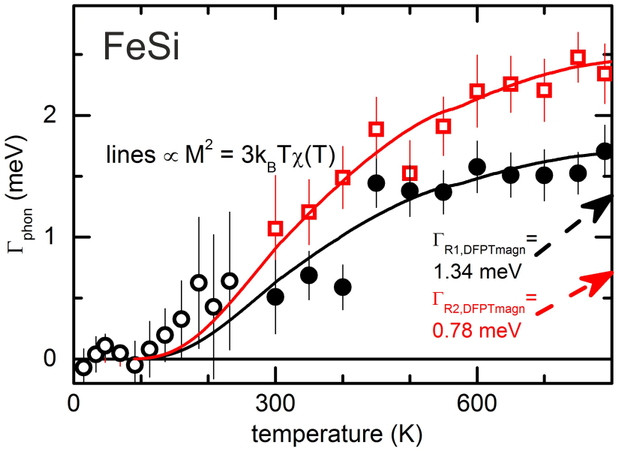
|
| Fig 5: Line widths of two phonon modes in FeSi located at q = (0.5,0.5,0.5) and energies of about 24 meV (black symbols) and 34 meV (red symbols )(2). The solid lines are based on volume magnetization measurements and demonstrate that the increase of the phonon line widths, i.e. the damping, correlates with the temperature activated paramagnetism in FeSi. |
|
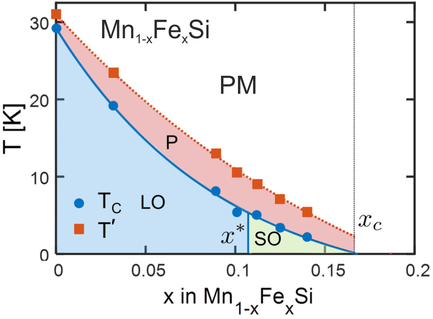
|
| Fig 6: Phase diagram of Mn1-xFexSi based on magnetization measurements and small-angle neutron scattering (3). The magnetic order is suppressed near xc ≈ 0.17. |
|
Phase competition in charge-ordered materials
Charge order appears as an important component in the phase diagrams of many correlated materials, including the cuprate high-Tc superconductors. Over the past decade, it has become increasingly clear that the idealized picture of charge order arising from a Fermi surface nesting instability does not apply to any realistic charge-ordered material. Instead, charge order seems to generically involve a delicate interplay between momentum dependent electron-phonon coupling and the effects of electronic correlations on the band structure. Various transition metal dichalcogenides, e.g. NbSe2, TiSe2, and MoS2, have served as prototypes over the past years to establish this generic understanding of charge order. The recognition of the central role of momentum dependent electron-phonon coupling, however, also opened up a series of new questions, particularly about its influence on short-ranged ordered phases, on the competition between distinct charge-ordered phases, and on the interplay between charge order and other types of order utilizing electron-phonon coupling, e.g. superconductivity. The interplay of charge order and superconductivity was in the focus of the Helmholtz Young Investigator Group "Competing phases in superconducting materials" (2012-2018). Based on the work within this group, our current interests are on inelastic x-ray scattering investigations of the transition metal dichalcogenides (Nb,Ti)Se2[6][14][15]. Rare-earth tritellurides, e.g. (Tb,Dy,Er)Te3, display different charge-ordered phases and we try to understand the interplay between these phases based on lattice dynamical considerations [16][17].
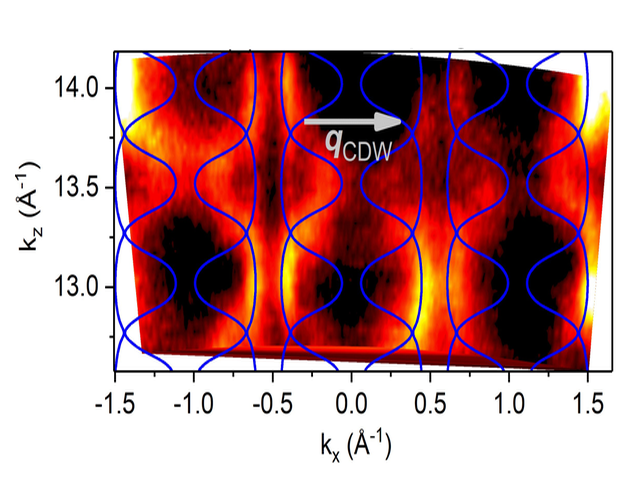
|
| Fig 7: Soft x-ray angle resolved photoemission spectroscopy on NbSe2(4). The results reveal a strong warping of the Fermi surface along the out-of-plane kzdirection. Hence, the CDW ordering wave vector qCDW (arrow) is not related to a nesting feature. Lines are DFT calculations. |
|
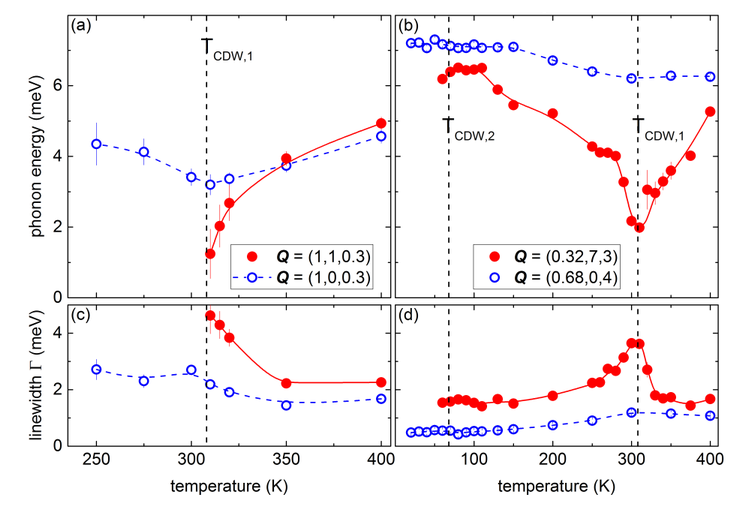
|
| Fig 8: Investigation of soft phonon modes in DyTe3 via inelastic x-ray scattering (5)(6). We observe a soft mode behavior only at the upper CDW transition (results in red at TCDW,1 = 308 K) but no lattice softening at the onset of the lower CDW order (TCDW,2 = 68 K). Our results are surprising since the nature of the ordering wave vectors qCDW,1 and qCDW,2 suggested a closely related nature and ordering mechanism of the two charge ordered phases. |
|






